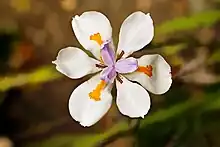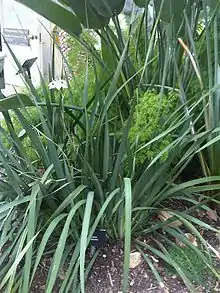Dietes iridioides
Dietes iridioides, commonly named African iris, fortnight lily, and morea iris, is a species of plant in the family Iridaceae that is native to Southern Africa.
| Dietes iridioides | |
|---|---|
 | |
| Scientific classification | |
| Kingdom: | Plantae |
| Clade: | Tracheophytes |
| Clade: | Angiosperms |
| Clade: | Monocots |
| Order: | Asparagales |
| Family: | Iridaceae |
| Genus: | Dietes |
| Species: | D. iridioides |
| Binomial name | |
| Dietes iridioides | |
| Synonyms | |
|
Dietes vegeta N.E.Br. | |
Description

This species has sarmentous stems with branches bearing lily-like flowers 6–8 centimetres (2.4–3.1 in) wide, white with yellow central markings. Growing up to 60 centimetres (24 in) in height and 30–60 centimetres (12–24 in) in spread, it forms dense basal tufts in the shape of an extended fan. Its preferred habitat is in semi-shade under tall, open trees. It has white flowers marked with yellow and violet, with six free tepals that are not joined into a tube at their bases. These flowers last only for a few days.
The seedpods of the plant often bend the stalks down to the ground where they have a better chance of propagating a new generation of plants.
Distribution
Dietes iridoides is widely distributed in Africa, from Ethiopia to South Africa.[1]
Taxonomy
These plants were formerly placed in the genus Moraea, but were reclassified because they are rhizomatous. Some references mention the species Dietes vegeta or D. vegeta variegata, springing from some confusion with Moraea vegata (which grows from a corm, not a rhizome). The name D. vegeta is commonly misapplied to both D. iridioides and D. grandiflora.
References
- "Dietes iridoides". World Checklist of Selected Plant Families. Royal Botanic Gardens, Kew. Retrieved 2015-08-10.
- Pink, A. (2004). Gardening for the Million. Project Gutenberg Literary Archive Foundation.
External links
- Dietes iridioides photo